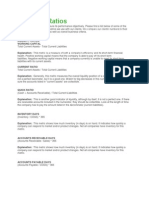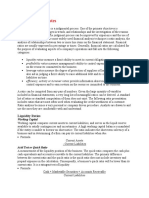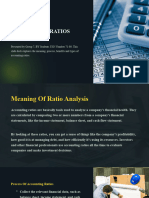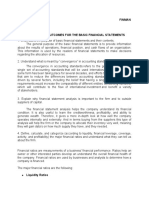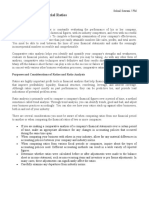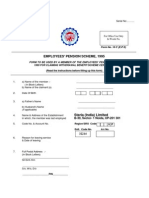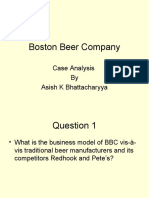Ratios and Formulas in Customer Financial Analysis
Ratios and Formulas in Customer Financial Analysis
Uploaded by
xmuhammad_aliCopyright:
Available Formats
Ratios and Formulas in Customer Financial Analysis
Ratios and Formulas in Customer Financial Analysis
Uploaded by
xmuhammad_aliOriginal Title
Copyright
Available Formats
Share this document
Did you find this document useful?
Is this content inappropriate?
Copyright:
Available Formats
Ratios and Formulas in Customer Financial Analysis
Ratios and Formulas in Customer Financial Analysis
Uploaded by
xmuhammad_aliCopyright:
Available Formats
Coverage ratios
Ratios used to test the adequacy of cash flows generated through earnings for purposes of meeting debt and lease obligations, including the interest coverage ratio and the fixed-charge coverage ratio.
Copyright 2004, Campbell R. Harvey. All Rights Reserved.
How to thank TFD for its existence? Tell a friend about us, add a link to this page, add the site to iGoogle, or visit webmaster's page for free fun content. Link to this page:
Ratios and Formulas in Customer Financial Analysis
Financial statement analysis is a judgmental process. One of the primary objectives is identification of major changes in trends, and relationships and the investigation of the reasons underlying those changes. The judgment process can be improved by experience and the use of analytical tools. Probably the most widely used financial analysis technique is ratio analysis, the analysis of relationships between two or more line items on the financial statement. Financial ratios are usually expressed in percentage or times. Generally, financial ratios are calculated for the purpose of evaluating aspects of a company's operations and fall into the following categories:
liquidity ratios measure a firm's ability to meet its current obligations. profitability ratios measure management's ability to control expenses and to earn a return on the resources committed to the business. leverage ratios measure the degree of protection of suppliers of long-term funds and can also aid in judging a firm's ability to raise additional debt and its capacity to pay its liabilities on time. efficiency, activity or turnover ratios provide information about management's ability to control expenses and to earn a return on the resources committed to the business.
A ratio can be computed from any pair of numbers. Given the large quantity of variables included in financial statements, a very long list of meaningful ratios can be derived. A standard list of ratios or standard computation of them does not exist. The following ratio presentation includes ratios that are most often used when evaluating the credit worthiness of a customer. Ratio analysis becomes a very personal or company driven procedure. Analysts are drawn to and use the ones they are comfortable with and understand.
Liquidity Ratios
Working Capital Working capital compares current assets to current liabilities, and serves as the liquid reserve available to satisfy contingencies and uncertainties. A high working capital balance is mandated if the entity is unable to borrow on short notice. The ratio indicates the short-term solvency of a business and in determining if a firm can pay its current liabilities when due. Formula
Current Assets - Current Liabilities Acid Test or Quick Ratio A measurement of the liquidity position of the business. The quick ratio compares the cash plus cash equivalents and accounts receivable to the current liabilities. The primary difference between the current ratio and the quick ratio is the quick ratio does not include inventory and prepaid expenses in the calculation. Consequently, a business's quick ratio will be lower than its current ratio. It is a stringent test of liquidity. Formula Cash + Marketable Securities + Accounts Receivable Current Liabilities Current Ratio Provides an indication of the liquidity of the business by comparing the amount of current assets to current liabilities. A business's current assets generally consist of cash, marketable securities, accounts receivable, and inventories. Current liabilities include accounts payable, current maturities of long-term debt, accrued income taxes, and other accrued expenses that are due within one year. In general, businesses prefer to have at least one dollar of current assets for every dollar of current liabilities. However, the normal current ratio fluctuates from industry to industry. A current ratio significantly higher than the industry average could indicate the existence of redundant assets. Conversely, a current ratio significantly lower than the industry average could indicate a lack of liquidity. Formula Current Assets Current Liabilities Cash Ratio Indicates a conservative view of liquidity such as when a company has pledged its receivables and its inventory, or the analyst suspects severe liquidity problems with inventory and receivables. Formula Cash Equivalents + Marketable Securities Current Liabilities
Profitability Ratios
Net Profit Margin (Return on Sales) A measure of net income dollars generated by each dollar of sales. Formula Net Income * Net Sales
* Refinements to the net income figure can make it more accurate than this ratio computation. They could include removal of equity earnings from investments, "other income" and "other expense" items as well as minority share of earnings and nonrecuring items. Return on Assets Measures the company's ability to utilize its assets to create profits. Formula Net Income * (Beginning + Ending Total Assets) / 2 Operating Income Margin A measure of the operating income generated by each dollar of sales. Formula Operating Income Net Sales Return on Investment Measures the income earned on the invested capital. Formula Net Income * Long-term Liabilities + Equity Return on Equity Measures the income earned on the shareholder's investment in the business. Formula Net Income * Equity Du Pont Return on Assets A combination of financial ratios in a series to evaluate investment return. The benefit of the method is that it provides an understanding of how the company generates its return. Formula Net Income * Sales Assets x x Sales Assets Equity Gross Profit Margin Indicates the relationship between net sales revenue and the cost of goods sold. This ratio should be compared with industry data as it may indicate insufficient volume and excessive purchasing or labor costs. Formula
Gross Profit Net Sales
Financial Leverage Ratio
Total Debts to Assets Provides information about the company's ability to absorb asset reductions arising from losses without jeopardizing the interest of creditors. Formula Total Liabilities Total Assets Capitalization Ratio Indicates long-term debt usage. Formula Long-Term Debt Long-Term Debt + Owners' Equity Debt to Equity Indicates how well creditors are protected in case of the company's insolvency. Formula Total Debt Total Equity Interest Coverage Ratio (Times Interest Earned) Indicates a company's capacity to meet interest payments. Uses EBIT (Earnings Before Interest and Taxes) Formula EBIT Interest Expense Long-term Debt to Net Working Capital Provides insight into the ability to pay long term debt from current assets after paying current liabilities. Formula Long-term Debt Current Assets - Current Liabilities
Efficiency Ratios
Cash Turnover Measures how effective a company is utilizing its cash. Formula Net Sales Cash Sales to Working Capital (Net Working Capital Turnover) Indicates the turnover in working capital per year. A low ratio indicates inefficiency, while a high level implies that the company's working capital is working too hard. Formula Net Sales Average Working Capital Total Asset Turnover Measures the activity of the assets and the ability of the business to generate sales through the use of the assets. Formula Net Sales Average Total Assets Fixed Asset Turnover Measures the capacity utilization and the quality of fixed assets. Formula Net Sales Net Fixed Assets Days' Sales in Receivables Indicates the average time in days, that receivables are outstanding (DSO). It helps determine if a change in receivables is due to a change in sales, or to another factor such as a change in selling terms. An analyst might compare the days' sales in receivables with the company's credit terms as an indication of how efficiently the company manages its receivables. Formula Gross Receivables Annual Net Sales / 365 Accounts Receivable Turnover Indicates the liquidity of the company's receivables. Formula Net Sales Average Gross Receivables
Accounts Receivable Turnover in Days Indicates the liquidity of the company's receivables in days. Formula Average Gross Receivables Annual Net Sales / 365 Days' Sales in Inventory Indicates the length of time that it will take to use up the inventory through sales. Formula Ending Inventory Cost of Goods Sold / 365 Inventory Turnover Indicates the liquidity of the inventory. Formula Cost of Goods Sold Average Inventory Inventory Turnover in Days Indicates the liquidity of the inventory in days. Formula Average Inventory Cost of Goods Sold / 365 Operating Cycle Indicates the time between the acquisition of inventory and the realization of cash from sales of inventory. For most companies the operating cycle is less than one year, but in some industries it is longer. Formula Accounts Receivable Turnover in Days + Inventory Turnover in Day Days' Payables Outstanding Indicates how the firm handles obligations of its suppliers. Formula Ending Accounts Payable Purchases / 365 Payables Turnover Indicates the liquidity of the firm's payables.
Formula Purchases Average Accounts Payable Payables Turnover in Days Indicates the liquidity of the firm's payables in days. Formula Average Accounts Payable Purchases / 365
Additional Ratios
Altman Z-Score The Z-score model is a quantitative model developed in 1968 by Edward Altman to predict bankruptcy (financial distress) of a business, using a blend of the traditional financial ratios and a statistical method known as multiple discriminant analysis. The Z-score is known to be about 90% accurate in forecasting business failure one year into the future and about 80% accurate in forecasting it two years into the future. Formula Z = 1.2 x (Working Capital / Total Assets) +1.4 x (Retained Earnings / Total Assets) +0.6 x (Market Value of Equity / Book Value of Debt) +0.999 x (Sales / Total Assets) +3.3 x (EBIT / Total Assets) Probability of Failure less than 1.8 Very High greater than 1.81 but less than 2.99 Not Sure greater than 3.0 Unlikely Bad-Debt to Accounts Receivable Ratio Bad-debt to Accounts Receivable ratio measures expected uncollectibility on credit sales. An increase in bad debts is a negative sign, since it indicates greater realization risk in accounts receivable and possible future write-offs. Formula Bad Debts Accounts Receivable Bad-Debt to Sales Ratio Bad-debt ratios measure expected uncollectibility on credit sales. An increase in bad debts is a Z-score
negative sign, since it indicates greater realization risk in accounts receivable and possible future write-offs. Formula Bad Debts Sales Book Value per Common Share Book value per common share is the net assets available to common stockholders divided by the shares outstanding, where net assets represent stockholders' equity less preferred stock. Book value per share tells what each share is worth per the books based on historical cost. Formula (Total Stockholders' Equity - Liquidation Value of Preferred Stocks - Preferred Dividends in Arrears) Common Shares Outstanding Common Size Analysis In vertical analysis of financial statements, an item is used as a base value and all other accounts in the financial statement are compared to this base value. On the balance sheet, total assets equal 100% and each asset is stated as a percentage of total assets. Similarly, total liabilities and stockholder's equity are assigned 100%, with a given liability or equity account stated as a percentage of total liabilities and stockholder's equity. On the income statement, 100% is assigned to net sales, with all revenue and expense accounts then related to it. Cost of Credit The cost of credit is the cost of not taking credit terms extended for a business transaction. Credit terms usually express the amount of the cash discount, the date of its expiration, and the due date. A typical credit term is 2 / 10, net / 30. If payment is made within 10 days, a 2 percent cash discount is allowed: otherwise, the entire amount is due in 30 days. The cost of not taking the cash discount can be substantial. Formula % Discount 360 x 100 - % Discount Credit Period - Discount Period Example On a $1,000 invoice with terms of 2 /10 net 30, the customer can either pay at the end of the 10 day discount period or wait for the full 30 days and pay the full amount. By waiting the full 30 days, the customer effectively borrows the discounted amount for 20 days. $1,000 x (1 - .02) = $980 This gives the amount paid in interest as:
$1,000 - 980 = $20 This information can be used to compute the credit cost of borrowing this money. % Discount 360 x 100 - % Discount Credit Period - Discount Period = 2 360 x = .3673 98 20 As this example illustrates, the annual percentage cost of offering a 2/10, net/30 trade discount is almost 37%. Current-Liability Ratios Current-liability ratios indicate the degree to which current debt payments will be required within the year. Understanding a company's liability is critical, since if it is unable to meet current debt, a liquidity crisis looms. The following ratios are compared to industry norms. Formulas Current to Non-current = Current Liabilities Non-current Liabilities Current to Total = Current Liabilities Total Liabilities
Rule of 72 A rule of thumb method used to calculate the number of years it takes to double an investment. Formula 72 Rate of Return Example Paul bought securities yielding an annual return of 9.25%. This investment will double in less than eight years because, 72 = 7.78 years 9.25
Copyright 1999 Credit Research Foundation All material on this site, CRFONLINE.COM, is created or provided by CREDIT RESEARCH FOUNDATION, including text, graphics, logos, icons, and images, are the property of CREDIT RESEARCH FOUNDATION or its content providers, and are protected by United States and foreign intellectual property laws. The compilation of all the content on this Site is the exclusive property of CREDIT RESEARCH FOUNDATION and is also protected by United States and foreign intellectual property laws. You may download, view, copy, and print the materials on this Site for personal use only, provided that you do not remove or alter any trademark, service mark, or logo, or any copyright or other intellectual property notices. Except as provided above, you may not download, view, copy, print, reproduce, distribute, republish, display, post, transmit, or modify any material, or portion thereof, located
on the Site in any form or by any means without the prior written consent of CREDIT RESEARCH FOUNDATION. CREDIT RESEARCH FOUNDATION reserves the right to revoke any of the rights granted in these Terms of Use at any time, and those rights automatically terminate if you violate any of these Terms of Use. Upon revocation or termination of such rights, you must destroy any digital or printed copies obtained from any portion of the Site. Unauthorized use of any material on the Site may violate copyright law, trademark law, and other laws of the United States and other jurisdictions. All rights not expressly granted in these Terms of Use are reserved. CREDIT RESEARCH FOUNDATION and the CREDIT RESEARCH FOUNDATION logo are the trademarks of CREDIT RESEARCH FOUNDATION. The other trademarks, service marks, and logos used on the Site are trademarks of CREDIT RESEARCH FOUNDATION or others. Nothing on the Site shall be construed as granting, by implication, estoppel, or otherwise, any license or right to use any trademark without the prior written consent of CREDIT RESEARCH FOUNDATION. The designations , , , SM or any
You might also like
- Understanding Financial Statements (Review and Analysis of Straub's Book)From EverandUnderstanding Financial Statements (Review and Analysis of Straub's Book)Rating: 5 out of 5 stars5/5 (5)
- PerfectGoldPortfolio PDFDocument5 pagesPerfectGoldPortfolio PDFOlga Yu100% (3)
- Lease and Sales & LeasebackDocument4 pagesLease and Sales & LeasebackSandeep Agrawal100% (1)
- Ulas in Customer Financial Analysis: Liquidity RatiosDocument9 pagesUlas in Customer Financial Analysis: Liquidity RatiosVarun GandhiNo ratings yet
- Ratios and Formulas in Customer Financial AnalysisDocument11 pagesRatios and Formulas in Customer Financial AnalysisPrince Kumar100% (1)
- Financial Ratios Liquidity Ratios: Working CapitalDocument9 pagesFinancial Ratios Liquidity Ratios: Working CapitalLen-Len CobsilenNo ratings yet
- Financial RatiosDocument21 pagesFinancial RatiosAamir Hussian100% (1)
- Importance of Financial StatementDocument11 pagesImportance of Financial StatementJAY SHUKLANo ratings yet
- Ratio Analysis Notes: Liquidity RatiosDocument7 pagesRatio Analysis Notes: Liquidity RatiosShaigari VenkateshNo ratings yet
- 5 Key Financial Ratios and How To Use ThemDocument10 pages5 Key Financial Ratios and How To Use ThemdiahNo ratings yet
- Business Accounting RatiosDocument18 pagesBusiness Accounting RatiosAhmed AdelNo ratings yet
- Pegasus Ratio Analysis1 (1) Final-1Document38 pagesPegasus Ratio Analysis1 (1) Final-1Bella BellNo ratings yet
- Module 2Document27 pagesModule 2MADHURINo ratings yet
- Financial RatiosDocument4 pagesFinancial Ratiossferaro.fngNo ratings yet
- 5 Key Financial Ratios and How To Use ThemDocument10 pages5 Key Financial Ratios and How To Use ThemNigussie GodanaNo ratings yet
- 4 Reasons Why Ratios and Proportions Are So ImportantDocument8 pages4 Reasons Why Ratios and Proportions Are So ImportantShaheer MehkariNo ratings yet
- Financial Analysis and Reporting (FM 222) : 1 Semester, School Year 2022-2023Document60 pagesFinancial Analysis and Reporting (FM 222) : 1 Semester, School Year 2022-2023Lai Alvarez100% (1)
- Workbook On Ratio AnalysisDocument9 pagesWorkbook On Ratio AnalysisZahid HassanNo ratings yet
- Current Ratio Liquidity Working CapitalDocument3 pagesCurrent Ratio Liquidity Working CapitalAldren Delina RiveraNo ratings yet
- Ratio Analysis: S. No. Ratios FormulasDocument11 pagesRatio Analysis: S. No. Ratios Formulasaashir chNo ratings yet
- A Comprehensive Projecect ON A COMPARATIVE STUDY ON Financial Performance "Tata Motors LTD." and "Bajaj Auto LTD." Submitted ToDocument27 pagesA Comprehensive Projecect ON A COMPARATIVE STUDY ON Financial Performance "Tata Motors LTD." and "Bajaj Auto LTD." Submitted ToPatel RuchitaNo ratings yet
- Accounting Ratios Am 71 80Document36 pagesAccounting Ratios Am 71 80Sandy100% (1)
- Use and Users of Ratio AnalysisDocument8 pagesUse and Users of Ratio AnalysisMad DinNo ratings yet
- 16 Financial Ratios To Determine A Company's Strength and WeaknessesDocument5 pages16 Financial Ratios To Determine A Company's Strength and WeaknessesOld School Value88% (8)
- Finance Chapter 4 Online PDFDocument43 pagesFinance Chapter 4 Online PDFJoseph TanNo ratings yet
- Chap 6 (Fix)Document13 pagesChap 6 (Fix)Le TanNo ratings yet
- Return On Assets (ROA) : Index of Industrial Production IIP Purchasing Managers' Index PMIDocument4 pagesReturn On Assets (ROA) : Index of Industrial Production IIP Purchasing Managers' Index PMIMuskan MNo ratings yet
- Chapter 2Document12 pagesChapter 2bhavana bhumarajuNo ratings yet
- FSA Notes IDocument10 pagesFSA Notes Iparinita raviNo ratings yet
- Study Guide Module 10Document16 pagesStudy Guide Module 10Ryan Paul MangaliagNo ratings yet
- L3Ratio Analysis 04102024 045847pmDocument31 pagesL3Ratio Analysis 04102024 045847pmrida.noor171No ratings yet
- The Language of BusinessDocument41 pagesThe Language of Businessrowealyn fabreNo ratings yet
- Financial Ratio MBA Complete ChapterDocument19 pagesFinancial Ratio MBA Complete ChapterDhruv100% (1)
- Malinab Aira Bsba FM 2-2 Activity 4 The Basic Financial StatementsDocument10 pagesMalinab Aira Bsba FM 2-2 Activity 4 The Basic Financial StatementsAira MalinabNo ratings yet
- Financial Statement Analysis: RatiosDocument23 pagesFinancial Statement Analysis: RatiosHerraNo ratings yet
- Financial Ratios: Arab British Academy For Higher EducationDocument6 pagesFinancial Ratios: Arab British Academy For Higher EducationhirenpadaliaNo ratings yet
- Account RatioDocument10 pagesAccount RatioNicholas OgollaNo ratings yet
- Financial Ratio AnalysisDocument4 pagesFinancial Ratio AnalysisFSLACCTNo ratings yet
- Lecture 1. Ratio Analysis Financial AppraisalDocument11 pagesLecture 1. Ratio Analysis Financial AppraisaltiiworksNo ratings yet
- Financial RatiosDocument7 pagesFinancial RatiosFazal JamroNo ratings yet
- Financial Analysis FundamentalsDocument12 pagesFinancial Analysis FundamentalsAni Dwi Rahmanti RNo ratings yet
- Financial Ratios: Use and Users of Ratio AnalysisDocument11 pagesFinancial Ratios: Use and Users of Ratio AnalysisSantosh SanNo ratings yet
- Financial Ratios....Document19 pagesFinancial Ratios....carlNo ratings yet
- How To Evaluate FSDocument8 pagesHow To Evaluate FSStephany PolinarNo ratings yet
- FM Assignment 1Document4 pagesFM Assignment 1Jeryco Quijano BrionesNo ratings yet
- Financial Ratios Are Useful Indicators of A Firm's Performance and FinancialDocument5 pagesFinancial Ratios Are Useful Indicators of A Firm's Performance and FinancialSef Getizo CadoNo ratings yet
- Analysis of Financial Statements: Answers To Selected End-Of-Chapter QuestionsDocument9 pagesAnalysis of Financial Statements: Answers To Selected End-Of-Chapter Questionsfeitheart_rukaNo ratings yet
- Short-Term Solvency or Liquidity Ratios: Current RatioDocument18 pagesShort-Term Solvency or Liquidity Ratios: Current RatioSachini Dinushika KankanamgeNo ratings yet
- Accounts Isc Final ProjectDocument13 pagesAccounts Isc Final ProjectRahit Mitra100% (2)
- CH 2Document13 pagesCH 2gech95465195No ratings yet
- Financial Analysis RatiosDocument10 pagesFinancial Analysis RatiosTjan Tiong GieNo ratings yet
- Understanding Financial RatiosDocument14 pagesUnderstanding Financial Ratiossofyan timotyNo ratings yet
- Financial Health: What Is 'Working Capital'Document11 pagesFinancial Health: What Is 'Working Capital'arhijaziNo ratings yet
- Business FinanceDocument3 pagesBusiness FinanceAnsel SaldeNo ratings yet
- Types Financial RatiosDocument8 pagesTypes Financial RatiosRohit Chaudhari100% (1)
- Assessing Future and Current Performance of Organisations Using Ratio AnalysisDocument11 pagesAssessing Future and Current Performance of Organisations Using Ratio AnalysisGeorge Rabar100% (1)
- Accounting Ratio'sDocument26 pagesAccounting Ratio'sRajesh Jyothi100% (1)
- Theoretical PerspectiveDocument12 pagesTheoretical PerspectivepopliyogeshanilNo ratings yet
- Balance Sheet Ratio Analysis FormulaDocument9 pagesBalance Sheet Ratio Analysis FormulaAbu Jahid100% (1)
- Evaluating A Firms Financial Performance by Keown3Document36 pagesEvaluating A Firms Financial Performance by Keown3talupurum100% (1)
- ROEDocument7 pagesROEfrancis willie m.ferangco100% (1)
- Brochure CBS Mergers and Acquisitions (Online) 07-09-2022 V20Document13 pagesBrochure CBS Mergers and Acquisitions (Online) 07-09-2022 V20Moises GutiérrezNo ratings yet
- Employees' Pension Scheme, 1995: Form No. 10 C (E.P.S)Document4 pagesEmployees' Pension Scheme, 1995: Form No. 10 C (E.P.S)aasifimamNo ratings yet
- Impact of Interest RateDocument7 pagesImpact of Interest RateMary AikhuomobhogbeNo ratings yet
- Floating Rate Note Pricing V3Document9 pagesFloating Rate Note Pricing V3QuantmetrixNo ratings yet
- Indian Income Tax Return Acknowledgement: mises/Building/VillageDocument1 pageIndian Income Tax Return Acknowledgement: mises/Building/Villagenilabh007No ratings yet
- Building Economics Complete NotesDocument20 pagesBuilding Economics Complete NotesManish MishraNo ratings yet
- Need For The StudyDocument21 pagesNeed For The StudykhayyumNo ratings yet
- CSEC Principles of Accounts SEC. 3-Petty Cash and Gen. JournalDocument26 pagesCSEC Principles of Accounts SEC. 3-Petty Cash and Gen. JournalEphraim Pryce100% (1)
- Whitepaper MX MessagesDocument13 pagesWhitepaper MX MessagesRiti KumariNo ratings yet
- Digital India: How Far Did Demonetization HelpDocument39 pagesDigital India: How Far Did Demonetization HelpSherin SunnyNo ratings yet
- Income From Property Frequently Asked Questions - HandoutDocument12 pagesIncome From Property Frequently Asked Questions - Handoutkwok wing kwanNo ratings yet
- VP Director Accounting Policy in Washington DC Resume Dayna KasermanDocument2 pagesVP Director Accounting Policy in Washington DC Resume Dayna KasermanDaynaKasermanNo ratings yet
- TOA.03-06 - NCAHFS, Discontinued Operations, Bio Assets, Interim and Segment ReportingDocument4 pagesTOA.03-06 - NCAHFS, Discontinued Operations, Bio Assets, Interim and Segment ReportingMerliza JusayanNo ratings yet
- Boston Beer Company: Case Analysis by Asish K BhattacharyyaDocument16 pagesBoston Beer Company: Case Analysis by Asish K Bhattacharyyaadrishm0% (1)
- Ctryprem July 23Document184 pagesCtryprem July 23Norman ZatykoNo ratings yet
- Annexure J TDS Declaration Format Under Rule 37BADocument2 pagesAnnexure J TDS Declaration Format Under Rule 37BASusovan SirNo ratings yet
- Accounting Business & Management 2 Grade 12: Summative Test No. 2Document2 pagesAccounting Business & Management 2 Grade 12: Summative Test No. 2bimbo serrotNo ratings yet
- CS Equity Research Citi ReportDocument10 pagesCS Equity Research Citi ReportnickNo ratings yet
- XxsarvananxxDocument8 pagesXxsarvananxxDr.K.BaranidharanNo ratings yet
- Analysis of Housing Finance Schemes of HDFC Bank ICICI Bank PNB SBI BankDocument85 pagesAnalysis of Housing Finance Schemes of HDFC Bank ICICI Bank PNB SBI BanksindhukotaruNo ratings yet
- LTAV EnglishDocument4 pagesLTAV EnglishBrizamar AguiarNo ratings yet
- Factory Ledger and General LedgerDocument5 pagesFactory Ledger and General Ledgerapi-224920675No ratings yet
- Lista Pacticienilor in Insolventa Agreeati de ANAFDocument93 pagesLista Pacticienilor in Insolventa Agreeati de ANAFLulu Mitica100% (1)
- Audited Financial Results For The Period Jan 23 To March 23Document14 pagesAudited Financial Results For The Period Jan 23 To March 23dayaanidhi2004No ratings yet
- Combined Address Change FormDocument2 pagesCombined Address Change FormsushikumNo ratings yet
- Virginia Co Has A Subsidiary in Hong Kong and inDocument1 pageVirginia Co Has A Subsidiary in Hong Kong and inAmit PandeyNo ratings yet
- WIndi Alifia Herdana - PR PIUTANG WESELDocument3 pagesWIndi Alifia Herdana - PR PIUTANG WESELWindi AlifiaNo ratings yet
- Interim FS TemplateDocument4 pagesInterim FS TemplateRyou ShinodaNo ratings yet






